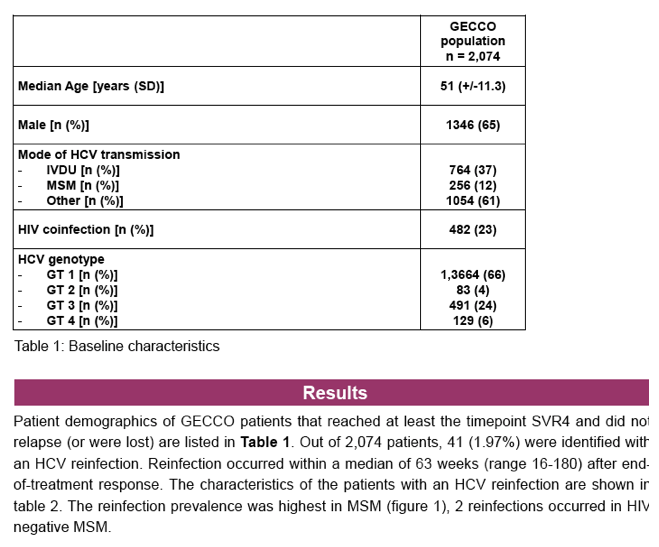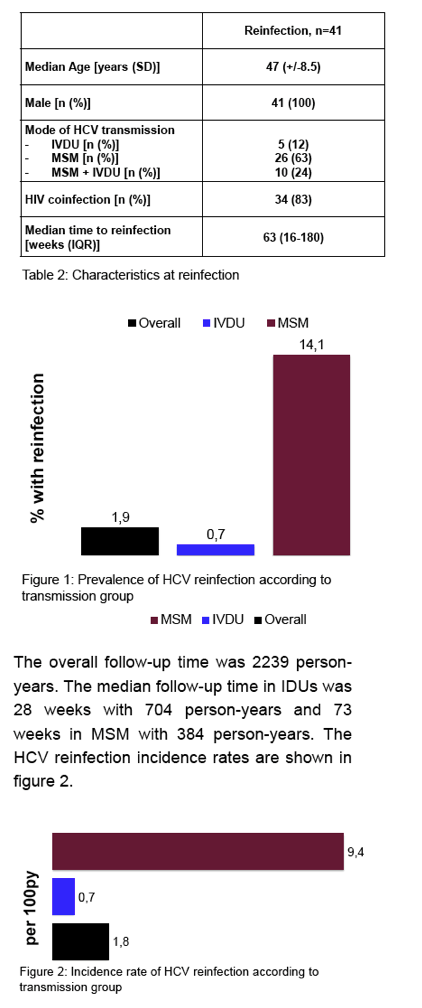 |
 |
 |
| |
Nine of 100 MSM in German Cohort Get HCV Reinfection Every Year in DAA Era
|
| |
| |
25th Conference on Retroviruses and Opportunistic Infections (CROI), March 4-7, 2018, Boston
Mark Mascolini
HCV reinfection incidence stood at 1.8 per 100 person-years in a large German cohort in the direct-acting antiviral (DAA) era [1]. Reinfection incidence reached 9.4 per 100 person-years in men who have sex with men (MSM) versus 0.7 per 100 in drug injectors.
Clinicians have seen HCV reinfection in people who inject drugs and MSM, with the latter group including both drug injectors and men who use noninjected drugs--mainly methamphetamine--to enhance sex. Because HCV reinfection rates remain poorly described since DAAs entered wide use, researchers working with the German Hepatitis C Cohort (GECCO) conducted this study.
Since February 2014 GECCO has enrolled people treated with DAAs at 9 centers in Germany, including people coinfected with HIV. This analysis excluded cohort members without a virologic response to therapy or who stopped making clinic visits. The researchers defined HCV reinfection as (1) detectable HCV RNA after an undetectable HCV RNA at least 12 weeks after the end of treatment (SVR12) or (2) an HCV genotype switch.
The cohort includes 2074 people, 65% of them men, with an average age of 51 (+/-11.3). While 37% acquired HCV when injecting drugs, 12% did so during gay sex, and 61% had "other" listed as their transmission mode. Almost one quarter of the group, 23%, had HIV coinfection.
Forty-one of 2074 cohort members (2%) got reinfected. Median time from DAA response to reinfection stood at 63 weeks and ranged from 16 to 180 weeks. Median age of reinfected people was 47, all were men, and 34 (83%) had HIV coinfection. HCV transmission mode was sex between men in 63%, sex between men plus drug injecting in 24%, and drug injecting alone in 12%.
Overall follow-up reached 2239 person-years (median 28 weeks in drug injectors and 73 weeks in MSM). During that time 14.1% of MSM got reinfected compared with 0.7% of drug injectors. HCV reinfection incidence measured 1.8 per 100 person-years overall, 0.7 per 100 person-years in drug injectors, and 9.4 per 100 person-years in MSM. Those rates mean 2 of 100 people overall got reinfected every year, while about 9 of 100 MSM got reinfected every year.
The GECCO investigators noted that the HCV reinfection rate in MSM in these DAA years is similar to the rate in pre-DAA days. This finding, they added, points to MSM "as a target population for close monitoring and specific behavioral interventions."
Reference
1. Ingiliz P, Wehmeyer M, Christensen S, et al. High incidence of HCV reinfection in MSM in the DAA era. 25th Conference on Retroviruses and Opportunistic Infections (CROI). March 4-7, 2018. Boston. Abstract 612.



|
| |
|
 |
 |
|
|